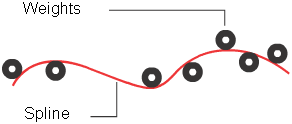Splines are types of curves, originally developed for ship-building in the days before computer modeling. Naval architects needed a way to draw a smooth curve through a set of points.

The solution was to place metal weights (called knots) at the control points, and bend a thin metal or wooden beam (called a spline) through the weights.
The physics of the bending spline meant that the influence of each weight was greatest at the point of contact, and decreased smoothly further along the spline. To get more control over a certain region of the spline, the draftsman simply added more weights.
This scheme had obvious problems with data exchange! People needed a mathematical way to describe the shape of the curve. Cubic Polynomials Splines are the mathematical equivalent of the draftsman’s wooden beam. Polynomials were extended to B-splines (for Basis splines), which are sums of lower-level polynomial splines.
Then B-splines were extended to create a mathematical representation called NURBS, which are used by Alias.